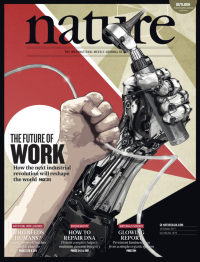Volume 550
-
No. 7677 26 October 2017
The cover shows an intricate network of lattice defects â dislocation lines â whose motion makes metal tantalum flow under compression. Fully dynamic atomistic simulations of plastic deformation in metals are extremely demanding computationally and usually involve mesoscale approximations. In this issue, Vasily Bulatov and his colleagues present fully dynamic atomic-level simulations of metal plasticity that feature up to 268 million atoms, each such simulation generating around 2 exabytes (1 exabyte = 1018 bytes) of data. Using their model, the authors probe how body-centred-cubic metal tantalum responds to ultrahigh-strain-rate deformation. They find that on reaching certain limiting conditions, dislocations can no longer relieve mechanical loads and twinning â the sudden reorientation of the crystal lattice â takes over. They also find that below such critical conditions, flow stress and dislocation density achieve a steady state in which the metal can be kneaded indefinitely like a piece of dough. Cover image: Alexander Stukowski
-
No. 7676 19 October 2017
The workplace is changing. Dramatic shifts in labour are reshaping society, the environment and the political landscape. Around the globe, computers and robots are poised to replace people in a wide variety of jobs. In this issue, Nature asks: what light is research shedding on the future of work and how will these changes affect scientistsâ working world? A News Feature explores three of the most studied questions about the future of work: what jobs are most at risk of automation? Do shifts to a decentralized âgig economyâ make good on their promise to democratize work around the world? And what kinds of programmes are best preparing workers for the coming changes? A Careers Feature examines the gig economy in more detail, revealing how freelance opportunities are remodelling what it means to be a researcher. And in three Comment pieces, Robert Allen provides a historical perspective on the relationship between wages and productivity; Yuval Noah Harari seeks new socio-economic models and a revolution in education; and Ian Goldin suggests that our era has more parallels with the Renaissance than the Industrial Revolution. Cover image: Chris Malbon
-
No. 7675 12 October 2017
The GTEx (Genotype-Tissue Expression) Consortium has established a reference catalogue and associated tissue biobank for gene-expression levels across individuals for diverse tissues of the human body, with a broad sampling of normal, non-diseased human tissues from postmortem donors. In an Article, the consortium presents the deepest survey of gene expression across multiple tissues and individuals to date, encompassing 7,051 samples from 449 donors across 44 human tissues. They characterize the relationship between genetic variation and gene expression across tissues and individuals, and find that most genes are regulated by genetic variation near to the affected gene. In accompanying Letters, Alexis Battle, Stephen Montgomery and their colleagues examine the impact of rare genetic variation on gene expression across human tissues. Daniel MacArthur and his team systematically survey the landscape of X chromosome inactivation in human tissues. And Jin Billy Li and his colleagues provide a comprehensive cross-species analysis of adenosine-to-inosine RNA editing in mammals. In an accompanying News & Views, Michelle Ward and Yoav Gilad put the latest results in context and discuss how these findings are helping to crack the regulatory code of the human genome. Cover image: Concept design: Christine A. Dahl. Graphics: Norm Cyr, Science Illustrator, Department of Pathology, Stanford Medicine
-
No. 7674 5 October 2017
The cover is a coloured scanning electron micrograph of various oral bacteria. The oral cavity was among six key body sites that formed a major focus in the work to expand the Human Microbiome Project reported on in this issue. Published in 2012, the Human Microbiome Project sampled 18 different body sites to provide a broad overview of the human microbiome in healthy individuals. Curtis Huttenhower and his colleagues have now extended this work to present 1,631 new metagenomes and multiple time points in 265 individuals, looking in particular at six sites, including the nostrils, mouth and gut. Using a combination of strain profiling, species-level metagenomic functional profiling and longitudinal analyses, the study provides deeper insights into human microbial communities, providing an important resource to further our understanding about what constitutes a âhealthyâ microbiota. Image courtesy: SPL/Getty




